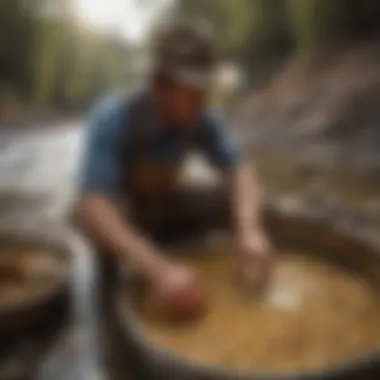Unveiling the Mastery of Utilizing a Gold Sluice Box for Precious Material Mining


Rock and Fossil Identification
To truly excel in the art of using a gold sluice box, it is crucial to understand the various types of rocks and fossils that may be encountered during the mining process. Identifying these materials accurately can significantly impact the success of your prospecting endeavors. Each rock and fossil has distinct characteristics that mining enthusiasts should be keen to recognize. Tools such as magnifying glasses, hardness picks, and UV lights can aid in the accurate identification of rocks and fossils, ensuring a productive and enriching mining experience.
Collecting Tips and Techniques
Embarking on a gold prospecting journey requires more than just technical knowledge - it demands a mastery of collecting tips and techniques to maximize efficiency. Adopting best practices in the collection process can streamline your efforts and lead to more fruitful outcomes. Locating prime collecting sites is a critical aspect that can make or break your prospecting success. By researching geological maps, consulting with seasoned prospectors, and leveraging modern technology like satellite imagery, identifying optimal collection spots becomes more achievable. Furthermore, knowing how to safely extract specimens without causing environmental damage is paramount in upholding ethical mining practices.
Preservation and Display
Once precious materials have been extracted using a gold sluice box, it is essential to preserve them properly to maintain their integrity and value. Various techniques, such as using consolidants, sealants, and protective coatings, can be employed to ensure the longevity of rocks and fossils. Proper storage methods, including the use of archival boxes, silica gel packets, and climate-controlled environments, are vital in preventing deterioration over time. For enthusiasts seeking to showcase their finds, creative display ideas like shadow boxes, mounted displays, and thematic arrangements can elevate the aesthetic appeal of their collections, enriching not only their personal space but also their overall prospecting experience.
Geological Insights
Delving deep into the world of rock and fossil identification opens doors to profound geological insights. By understanding the geological formations and processes that give rise to different rocks and fossils, prospectors can enhance their appreciation for the earth's intricate history. Exploring the historical significance attached to various rocks and fossils offers a glimpse into the past, unraveling stories of ancient lands and long-extinct creatures. Moreover, examining notable discoveries in the field sheds light on groundbreaking findings that have reshaped scientific understanding and enriched the field of geology.
Introduction
Gold sluice boxes have long been revered for their efficacy in extracting precious materials, providing a vital tool for enthusiasts and professionals alike in the realm of prospecting. This pivotal device lays the foundation for successful gold recovery processes, embodying a blend of engineering precision and natural forces. Understanding the nuances of a gold sluice box is essential for maximizing its potential and reaping the rewards of efficient prospecting ventures.
Understanding the Concept of a Gold Sluice Box
Construction and Design
The construction and design of a gold sluice box play a crucial role in its overall effectiveness. The meticulous crafting of materials, such as durable aluminum or lightweight plastic, ensures the sluice box's resilience to rugged terrains and varying water conditions. The incorporation of riffles and matting within the sluice box design enhances its gold capturing capabilities by creating trapping zones for heavier particles. This innovative feature sets the foundation for efficient gold recovery processes, distinguishing the sluice box as a preferred choice for prospectors seeking optimal results.
Functionality and Principles
The functionality and principles governing a gold sluice box underpin its success in separating gold from other sediments. By capitalizing on the principles of fluid dynamics and the natural movement of water, the sluice box utilizes gravity to segregate materials based on their weight and size. This intrinsic mechanism enables the box to channel and concentrate gold particles, ensuring a higher retention rate during the recovery process. The synergy between functionality and principles elevates the sluice box as a versatile tool that aligns with the goals of efficient gold prospecting endeavors.
Historical Evolution of Gold Sluice Boxes
Ancient Origins
The origins of gold sluice boxes can be traced back to ancient civilizations that leveraged water channels to extract gold from riverbeds. Early designs featured rudimentary wooden troughs that capitalized on water flow to separate heavier gold particles from lighter sediments. Despite their simplistic nature, these ancient sluice boxes laid the groundwork for modern innovations in gold recovery techniques, showcasing the enduring appeal of this age-old prospecting method.


Modern Innovations
In contemporary times, advancements in technology and materials have revolutionized the design and functionality of gold sluice boxes. Innovative features such as adjustable legs for varying incline angles and interchangeable riffle designs offer prospectors a customizable experience tailored to their specific needs. The integration of materials like high-impact plastic and corrosion-resistant metals has enhanced the durability and longevity of modern sluice boxes, making them indispensable tools in the arsenal of today's prospectors.
Benefits of Using a Gold Sluice Box
Efficiency in Gold Recovery
The efficiency of a gold sluice box in recovering precious metals stems from its ability to capture fine gold particles with remarkable precision. The strategic placement of riffles and matting within the sluice box maximizes gold retention rates, ensuring minimal loss during the prospecting process. This unparalleled efficiency sets the gold sluice box apart as a reliable method for recovering valuable gold deposits in a consistent and controlled manner.
Portability and Versatility
The portability and versatility of a gold sluice box make it an indispensable companion for prospectors exploring remote or challenging terrains. Its lightweight yet sturdy construction allows for easy transportation and swift assembly, enabling prospectors to set up and start prospecting with minimal effort. The adaptability of sluice boxes to varying water flow conditions and terrain features enhances their versatility, making them suitable for prospecting in diverse environments with ease and efficiency.
Setting Up Your Gold Sluice Box
Setting up your gold sluice box is a critical step in the gold prospecting process, shaping the foundation for successful mining endeavors. The meticulous preparation and placement of the sluice box can significantly impact the efficiency and effectiveness of gold recovery. By carefully selecting the appropriate location and assembling the sluice box correctly, prospectors can maximize their chances of capturing precious gold particles. The setup phase is paramount in ensuring a smooth and productive prospecting experience.
Choosing the Right Location for Prospecting
Factors to Consider
When selecting the ideal location for prospecting, various factors come into play. Factors such as water depth, flow rate, and proximity to gold-bearing areas must be thoroughly evaluated. Understanding the geological composition of the site and historical gold deposition patterns can guide prospectors in making informed decisions. Choosing a location with high gold potential and accessibility is crucial for optimizing gold recovery rates.
Optimal Geographical Features
Optimal geographical features play a pivotal role in the success of a gold prospecting operation. Features like exposed bedrock, areas of natural concentration, and access to steady water sources are highly favorable for sluice boxing. These features provide natural traps for gold particles and facilitate the sedimentation process, enhancing the efficiency of the gold recovery process. Prospecting in areas with optimal geographical features increases the likelihood of recovering significant quantities of gold.
Assembling and Installing the Sluice Box
Step-by-Step Guide
Assembling a sluice box requires meticulous attention to detail, starting from laying out the components to securing them in place. Each part must be accurately arranged to ensure seamless functionality during operation. Following a step-by-step guide for assembly helps in preventing errors and ensures the sluice box is set up correctly for gold recovery. Investing time in understanding the assembly process can save considerable effort later on and improve gold recovery efficiency.
Ensuring Stability and Efficiency


Stability and efficiency are paramount when installing a sluice box. Ensuring that the box is securely positioned and level on the waterway is essential to prevent shifting during operation. A stable sluice box allows for an uninterrupted flow of water and sediment through the riffles, maximizing the capture of gold particles. Efficiency in installation guarantees the smooth operation of the sluice box, ultimately leading to enhanced gold recovery results.
Calibrating the Sluice Box for Maximum Performance
Angle Adjustment
Adjusting the angle of the sluice box is crucial for optimizing gold recovery performance. The right angle promotes proper water flow and facilitates the movement of lighter materials down the sluice while capturing heavier gold particles. Finding the optimal angle based on the water flow rate and material consistency is key to maximizing gold retention. Fine-tuning the angle adjustment can significantly impact the overall efficiency of the sluice box in recovering gold.
Water Flow Optimization
Optimizing water flow within the sluice box is essential for efficient gold recovery. Regulating water flow to match the material being processed helps in washing away lighter sediments while retaining gold particles. Controlling the water velocity and volume ensures that gold is concentrated in the riffles for easier collection. Proper water flow optimization is a critical factor in achieving maximum gold recovery and minimizing gold losses.
Mastering Gold Recovery Techniques
In the realm of gold prospecting, mastering gold recovery techniques stands as a pinnacle skillset essential for maximizing returns. The ability to efficiently extract precious gold particles from material is paramount in gold sluicing. This article delves deep into the nuances of mastering these techniques, focusing on specific elements that elevate one's ability to recover gold effectively. By understanding the dynamics of gold recovery, enthusiasts and professionals can enhance their prospecting endeavors exponentially.
Classifying and Feeding Material into the Sluice Box
Particle Size Considerations
Particle size considerations play a crucial role in gold recovery efficiency within a sluice box setup. The size of materials run through the sluice impacts the capture rate of fine gold particles, making it a critical factor for success in prospecting. By analyzing particle sizes and their behavior within the sluice, prospectors can tailor their approach to ensure optimal recovery rates. This meticulous attention to detail in particle sizing distinguishes successful operations from mediocre ones, highlighting the importance of honing this skill in gold sluicing.
Uniform Distribution Techniques
Achieving uniform distribution of materials in the sluice box is indispensable for maximizing gold recovery. By employing techniques that promote even material flow throughout the equipment, prospectors can enhance overall efficiency and capture rates. Consistent distribution mitigates the risk of gold loss due to uneven concentration areas, elevating the quality of prospecting outcomes. This deliberate approach to uniform distribution not only boosts recovery but also showcases a meticulous commitment to optimizing the gold sluicing process.
Understanding Ripple Effects and Flow Dynamics
Impact on Fine Gold Recovery
The ripple effects and flow dynamics within a sluice box have a direct impact on fine gold recovery rates, making it a focal point for prospectors seeking to optimize their operations. Understanding how ripples influence the movement and capture of fine gold particles is crucial in fine-tuning sluice box setups. By leveraging the effects of ripples effectively, prospectors can increase recovery efficiency and minimize gold losses, thereby enhancing overall performance in gold sluicing.
Optimizing Water Velocity
The optimization of water velocity plays a pivotal role in the success of a sluice box operation. Controlling the speed at which water flows through the apparatus directly affects the transport and capture of gold particles. By fine-tuning water velocity to suit specific site conditions and material types, prospectors can significantly improve the recovery process. This meticulous adjustment of water velocity underscores the importance of precision in optimizing gold sluicing endeavors.


Cleaning Out and Processing Concentrates
Retrieving Trapped Gold Particles
One of the critical aspects of gold sluicing is the effective retrieval of trapped gold particles from concentrates. This process involves meticulous extraction methods to ensure no valuable material is left behind. By employing thorough techniques to recover trapped gold, prospectors can increase overall yield and reduce losses, showcasing a commitment to comprehensive resource recovery.
Utilizing Panning Techniques
Panning techniques play a significant role in the final stages of processing concentrates in gold sluicing. By utilizing panning methods to extract remaining gold particles from concentrates, prospectors can fine-tune their recovery process and secure every last trace of precious material. This meticulous approach to panning not only enhances recovery efficiency but also highlights the meticulous nature of gold prospecting endeavors.
Advanced Tips and Strategies
When delving into the intricate process of utilizing a gold sluice box, it is essential to consider advanced tips and strategies that can significantly impact the efficiency and success of your prospecting ventures. In this article, we focus on specific elements that elevate your gold recovery techniques and optimize your sluice box for maximum performance. By incorporating advanced tips and strategies, enthusiasts and professionals can enhance their prospecting experience and increase their chances of success.
Fine-Tuning Sluice Box Settings for Fine Gold Recovery
Adjusting Matting Materials
Adjusting matting materials plays a crucial role in fine-tuning a sluice box for optimal gold recovery. The key characteristic of matting materials lies in their ability to trap fine gold particles effectively, thus improving overall extraction rates. Choosing the right type of matting material can make a substantial difference in the amount of gold recovered. While each matting material has its advantages and disadvantages, selecting the most suitable option can significantly boost the efficiency of your gold sluice box.
Implementing Secondary Riffles
The implementation of secondary riffles in a sluice box is another essential strategy for enhancing gold recovery. Secondary riffles aid in capturing and retaining small gold particles that may otherwise be lost during the prospecting process. By utilizing secondary riffles, prospectors can increase the overall effectiveness of their sluice box and ensure maximum gold retention. Understanding the unique features and benefits of secondary riffles is paramount in optimizing gold recovery techniques for successful prospecting endeavors.
Utilizing Extended Sluice Boxes for Increased Capacity
Longitudinal Extensions
Integrating longitudinal extensions into a sluice box allows prospectors to enhance the capacity and efficiency of their gold recovery setup. The key characteristic of longitudinal extensions is their ability to extend the surface area available for gold trapping, thereby accommodating a larger volume of material for processing. By incorporating longitudinal extensions, individuals can optimize their prospecting output and increase the overall efficiency of their gold recovery operation. Understanding the advantages and potential limitations of longitudinal extensions is crucial for maximizing prospecting success.
Enhancing Production Rates
Enhancing production rates through strategic modifications to a sluice box is vital for increasing overall efficiency and output. The key characteristic of enhancing production rates is the potential to process larger quantities of material within a given timeframe, resulting in higher yields of recovered gold. By implementing techniques that enhance production rates, prospectors can make significant strides towards achieving their prospecting goals and maximizing their gold recovery potential. Exploring the unique features and benefits of enhancing production rates offers valuable insights for optimizing prospecting endeavors.
Implementing Safety Measures and Environmental Practices
Precautions for Wildlife Protection
Implementing precautions for wildlife protection is a responsible practice that aligns with ethical and environmental considerations in prospecting. The key characteristic of wildlife protection measures is their ability to minimize disturbances to local fauna and preserve the natural habitat during prospecting activities. By taking proactive steps to protect wildlife, prospectors can contribute to the conservation of biodiversity and ensure sustainable prospecting practices for future generations. Understanding the advantages and potential challenges of wildlife protection measures is essential for promoting responsible prospecting behavior.
Responsible Waste Management
Responsible waste management is critical for maintaining environmental integrity and adhering to regulatory standards in prospecting operations. The key characteristic of effective waste management practices is the ability to minimize environmental impact and promote sustainable resource utilization. By adopting responsible waste management strategies, prospectors can mitigate the adverse effects of prospecting activities on the ecosystem and demonstrate a commitment to environmental stewardship. Exploring the unique features and benefits of responsible waste management practices provides valuable insights for ensuring environmentally conscious prospecting practices.







